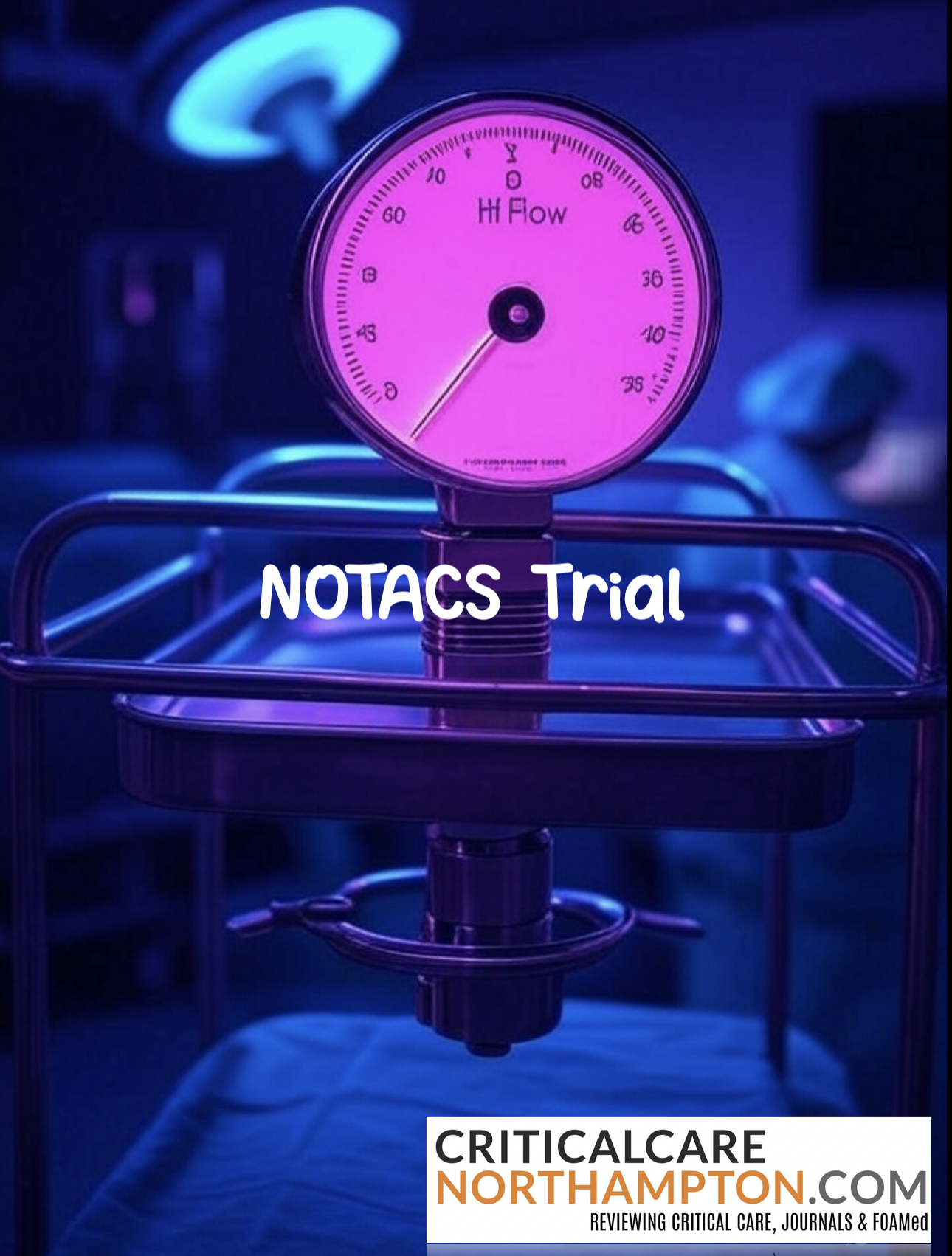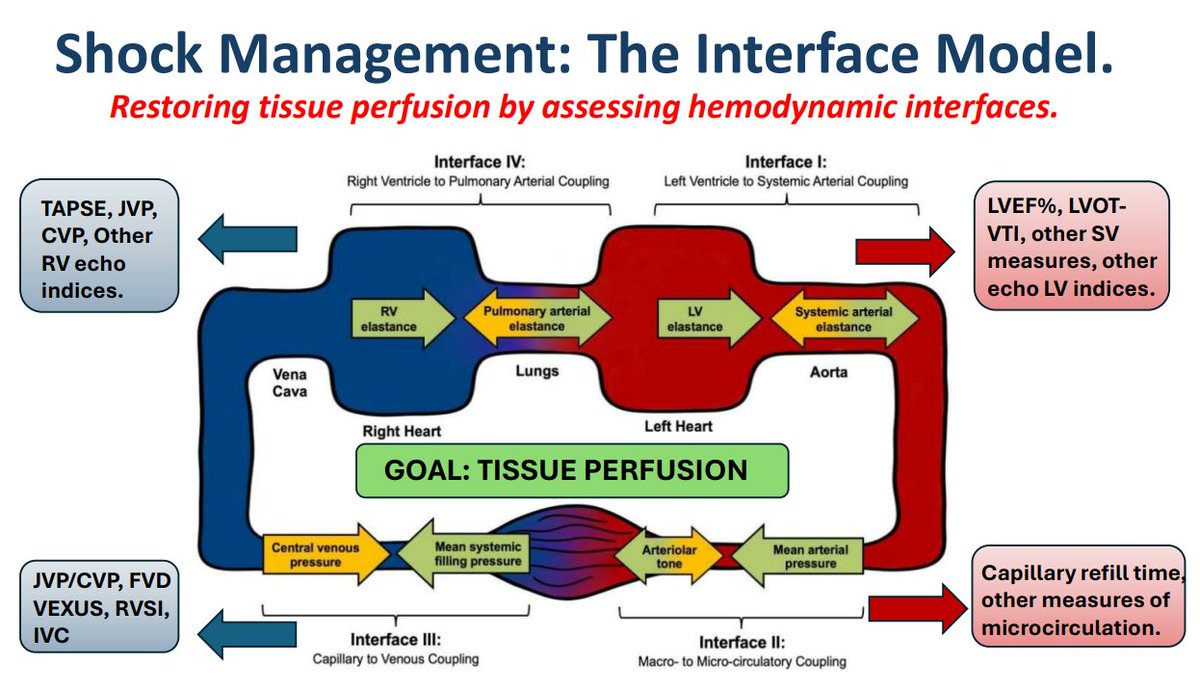What was it?
Multicenter, adaptive, single-blind, randomized controlled trial (NOTACS) evaluating high-flow nasal therapy (HFNT) versus standard oxygen therapy (SOT) in adult patients at high risk of postoperative pulmonary complications (PPCs) following cardiac surgery with cardiopulmonary bypass. The trial aimed to assess clinical and cost-effectiveness over 90 days post-surgery.
The Devil in the Details!
- 850–1280 patients (minimum 850, adaptive design allowing up to 1280) randomized 1:1 to HFNT or SOT, across 10 UK, 7 Australian, and 1 New Zealand sites.
- HFNT delivered for a minimum of 16 hours post-extubation (15 hours acceptable with 1-hour break for transfers/physiotherapy).
- Inclusion: Adults (≥18 years) undergoing elective or urgent first-time or redo cardiac surgery (CABG, valve surgery, aortic surgery, or combinations) with ≥1 risk factor for PPCs (COPD, asthma, recent lower respiratory tract infection, BMI ≥35 kg/m², or heavy smoking >10 pack-years within 6 weeks).
- Exclusion: Emergency surgery (<24 hours), contraindications to HFNT (e.g., nasal septal defect), home respiratory support (CPAP/BiPAP), or non-fluent English speakers without interpreter availability.
- Primary outcome: Days alive and at home within 90 days post-surgery (DAH90).
- Secondary outcomes: Mortality, PPCs, ICU re-admission, hospital/ICU length of stay, oxygenation (ROX index), quality of life (EQ-5D-5L), activities of daily living (BARTHEL questionnaire), and health service resource use.
- Economic evaluation: Incremental cost per DAH90 and quality-adjusted life years (QALYs) from health and social care perspectives.
- Interim sample size re-estimation (SSR) after ≥300 patients followed for 90 days, allowing adjustment up to 1280 patients.
The Results!
- No significant difference in DAH90 between HFNT and SOT groups in high-risk cardiac surgery patients.
- Over 50% of patients required additional support at home 90 days post-op, highlighting a significant recovery burden. Median hospital stay: 7 days; ICU stay: 2 days.
- Secondary outcomes (e.g., mortality, PPCs, ICU re-admission, hospital/ICU stay, oxygenation, quality of life) were assessed but not powered to detect differences. Specific results for these are not yet fully published in available data.
- HFNT was well-tolerated, with potential benefits in reducing secretion buildup and chest infections (e.g., pneumonia), though not statistically significant in interim reports.
- Economic evaluation ongoing, assessing cost-effectiveness and cost-utility (QALYs) at 30 and 90 days.
They concluded
The NOTACS investigators concluded that HFNT did not significantly improve DAH90 compared to SOT in high-risk cardiac surgery patients, raising questions about its routine prophylactic use. The high post-op support needs at 90 days suggest a need to address recovery burdens beyond oxygen therapy.
Gripe Point Summary!
Detailed gripes below, but key issues include:
- No significant primary outcome benefit (DAH90), questioning HFNT’s clinical utility.
- Adaptive design complexity may obscure interpretation.
- Single-blind design risks bias in patient-reported outcomes.
- High crossover rates (12% SOT to HFNT, 25% HFNT to SOT) dilute treatment effect.
- Exclusion of emergency surgery and non-English speakers limits generalizability.
- Interim SSR and unpublished final results create uncertainty.
- Focus on high-risk patients may not reflect broader cardiac surgery populations.
- Limited data on secondary outcomes and safety events.
Our Summary
In high-risk cardiac surgery patients, prophylactic HFNT for ≥16 hours post-extubation did not significantly increase days alive and at home (DAH90) compared to SOT. While HFNT may improve comfort and reduce minor pulmonary complications, its clinical and cost-effectiveness remains unproven. The trial’s adaptive design and international scope are strengths, but high crossover rates and lack of significant primary outcome benefit temper enthusiasm. Larger, finalized data and broader patient inclusion are needed to clarify HFNT’s role.
Who’s worked on this before?
Further Gripes
- Lack of primary outcome benefit: No significant DAH90 difference undermines HFNT’s value as a routine intervention, especially given its cost and resource demands.
- Adaptive design complexity: Interim SSR after 300 patients introduces variability in sample size (850–1280), potentially complicating statistical power and interpretation.
- Single-blind design: Patients were aware of treatment allocation, risking bias in subjective outcomes like EQ-5D-5L and BARTHEL scores.
- High crossover rates: 12% SOT to HFNT and 25% HFNT to SOT crossovers dilute intention-to-treat analysis, potentially masking true treatment effects.
- Exclusion criteria limit generalizability: Excluding emergency surgery patients and non-English speakers (without interpreters) narrows applicability, especially in diverse or acute settings.
- Unpublished final results: Interim findings and ongoing economic evaluation leave uncertainty about definitive outcomes, safety, and cost-effectiveness.
- Focus on high-risk patients: Inclusion of only high-risk PPC patients (COPD, asthma, BMI ≥35, etc.) may not reflect outcomes in lower-risk cardiac surgery populations.
- Secondary outcomes underpowered: Trial not designed to detect differences in mortality, PPCs, or ICU re-admission, limiting insights into HFNT’s broader impact.
- Potential for unrecorded confounders: Use of other respiratory interventions (e.g., CPAP for escalations) or local care protocols not fully documented, potentially confounding results.
- COVID-19 considerations: While patients were COVID-19 negative, local PPE and testing protocols may have varied across sites, affecting consistency.
- Device-specific concerns: HFNT devices (AIRVO 2) provided via loan from Fisher & Paykel, raising potential for industry bias, though not involved in study design.
CCN’s Reflection
The NOTACS trial is a robust, multicenter effort to evaluate HFNT’s role in high-risk cardiac surgery patients, leveraging an adaptive design and international collaboration. However, the lack of DAH90 benefit, high crossover rates, and single-blind design raise doubts about HFNT’s routine use. While HFNT may offer comfort and minor respiratory benefits, its cost-effectiveness remains unproven until final results are published. The trial highlights the recovery burden post-cardiac surgery, suggesting future research should focus on holistic rehabilitation strategies. For now, HFNT’s place in the ICU remains a question mark—promising but not yet a game-changer. Stay tuned for the final analysis!
Written by JW









